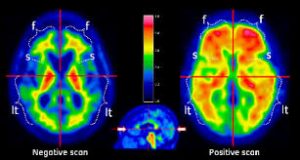 Florbetapir (18F), sold under the brand name Amyvid, is a PET scanning radiopharmaceutical compound containing the radionuclide fluorine-18 approved as a diagnostic tool for Alzheimer’s disease.
Florbetapir (18F), sold under the brand name Amyvid, is a PET scanning radiopharmaceutical compound containing the radionuclide fluorine-18 approved as a diagnostic tool for Alzheimer’s disease.
Florbetapir, like Pittsburgh compound B (PiB), binds to beta-amyloid, however fluorine-18 has a half-life of 109.75 minutes, in contrast to PiB’s radioactive half life of 20 minutes.
The longer life allowed the tracer to accumulate significantly more in the brains of people with Alzheimer’s disease particularly in the regions known to be associated with beta-amyloid deposits.
The only certain way to determine if a person indeed has AZ was to perform a biopsy on the patient’s brain to find distinctive spots on the brain that show the buildup of amyloid plaque.
To diagnose AZ in patients with memory loss and dementia based on symptoms, and as many as 20% of patients diagnosed with the disease are found after examination of the brain following death not to have had the condition.
Other diagnostic tools for AZ such as analysis of cerebrospinal fluid, magnetic resonance imaging scans looking for brain shrinkage and PET scans looking at how glucose was used in the brain, have all been unreliable.
Florbetapir (Pittsburgh compound B) detects amyloid plaque.
Pittsburgh compound B relies on the use of carbon-11, a radioactive isotope with a half-life of 20 minutes that requires the immediate use of the material prepared in a cyclotron.
Isotope that could be injected into the body, would cross the blood–brain barrier and attach itself to amyloid protein deposits in the brain.
Positron-emitting fluorine-18, a radioactive isotope with a half-life over five times longer is used in PET scans, and that can last for as long as a day when prepared in the morning by cyclotron.
The tests found amyloid plaque in 20% of its test patients over age 60 that had been in the normal range, but had performed worse than a control group on tests of mental acuity.
Studies were successful in distinguishing between those with Alzheimer’s and those without the disease, based on autopsy findings and correlation with F1 studies.
The technique provides a means to reliably diagnose and monitor the progress of Alzheimer’s and allows potential pharmaceutical treatments to be evaluated.
